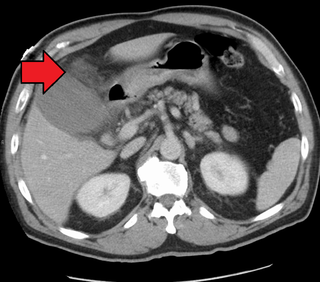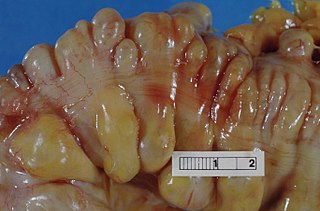Related Research Articles

Non-steroidal anti-inflammatory drugs (NSAID) are members of a therapeutic drug class which reduces pain, decreases inflammation, decreases fever, and prevents blood clots. Side effects depend on the specific drug, its dose and duration of use, but largely include an increased risk of gastrointestinal ulcers and bleeds, heart attack, and kidney disease.

Appendicitis is inflammation of the appendix. Symptoms commonly include right lower abdominal pain, nausea, vomiting, and decreased appetite. However, approximately 40% of people do not have these typical symptoms. Severe complications of a ruptured appendix include widespread, painful inflammation of the inner lining of the abdominal wall and sepsis.
Delirium is a specific state of acute confusion attributable to the direct physiological consequence of a medical condition, effects of a psychoactive substance, or multiple causes, which usually develops over the course of hours to days. As a syndrome, delirium presents with disturbances in attention, awareness, and higher-order cognition. People with delirium may experience other neuropsychiatric disturbances, including changes in psychomotor activity, disrupted sleep-wake cycle, emotional disturbances, disturbances of consciousness, or, altered state of consciousness, as well as perceptual disturbances, although these features are not required for diagnosis.

Cholecystitis is inflammation of the gallbladder. Symptoms include right upper abdominal pain, pain in the right shoulder, nausea, vomiting, and occasionally fever. Often gallbladder attacks precede acute cholecystitis. The pain lasts longer in cholecystitis than in a typical gallbladder attack. Without appropriate treatment, recurrent episodes of cholecystitis are common. Complications of acute cholecystitis include gallstone pancreatitis, common bile duct stones, or inflammation of the common bile duct.

C-reactive protein (CRP) is an annular (ring-shaped) pentameric protein found in blood plasma, whose circulating concentrations rise in response to inflammation. It is an acute-phase protein of hepatic origin that increases following interleukin-6 secretion by macrophages and T cells. Its physiological role is to bind to lysophosphatidylcholine expressed on the surface of dead or dying cells in order to activate the complement system via C1q.

Cluster headache (CH) is a neurological disorder characterized by recurrent severe headaches on one side of the head, typically around the eye(s). There is often accompanying eye watering, nasal congestion, or swelling around the eye on the affected side. These symptoms typically last 15 minutes to 3 hours. Attacks often occur in clusters which typically last for weeks or months and occasionally more than a year.

Abdominal pain, also known as a stomach ache, is a symptom associated with both non-serious and serious medical issues. Since the abdomen contains most of the body's vital organs, it can be an indicator of a wide variety of diseases. Given that, approaching the examination of a person and planning of a differential diagnosis is extremely important.

Procalcitonin (PCT) is a peptide precursor of the hormone calcitonin, the latter being involved with calcium homeostasis. It arises once preprocalcitonin is cleaved by endopeptidase. It was first identified by Leonard J. Deftos and Bernard A. Roos in the 1970s. It is composed of 116 amino acids and is produced by parafollicular cells of the thyroid and by the neuroendocrine cells of the lung and the intestine.

Diverticulitis, also called colonic diverticulitis, is a gastrointestinal disease characterized by inflammation of abnormal pouches—diverticula—that can develop in the wall of the large intestine. Symptoms typically include lower abdominal pain of sudden onset, but the onset may also occur over a few days. There may also be nausea, diarrhea or constipation. Fever or blood in the stool suggests a complication. People may experience a single attack, repeated attacks, or ongoing "smouldering" diverticulitis.

Fitz-Hugh–Curtis syndrome is a rare complication of pelvic inflammatory disease (PID) involving liver capsule inflammation leading to the formation of adhesions presenting with the clinical syndrome of right upper quadrant (RUQ) pain.
In immunology, systemic inflammatory response syndrome (SIRS) is an inflammatory state affecting the whole body. It is the body's response to an infectious or noninfectious insult. Although the definition of SIRS refers to it as an "inflammatory" response, it actually has pro- and anti-inflammatory components.
Inflammatory breast cancer (IBC) is one of the most aggressive types of breast cancer. It can occur in women of any age. It is referred to as "inflammatory" due to its frequent presentation with symptoms resembling a skin inflammation, such as erysipelas.

Acute pancreatitis (AP) is a sudden inflammation of the pancreas. Causes, in order of frequency, include: a gallstone impacted in the common bile duct beyond the point where the pancreatic duct joins it; heavy alcohol use; systemic disease; trauma; and, in children, mumps. Acute pancreatitis may be a single event; it may be recurrent; or it may progress to chronic pancreatitis.

Gastrointestinal perforation, also known as gastrointestinal rupture, is a hole in the wall of the gastrointestinal tract. The gastrointestinal tract is composed of hollow digestive organs leading from the mouth to the anus. Symptoms of gastrointestinal perforation commonly include severe abdominal pain, nausea, and vomiting. Complications include a painful inflammation of the inner lining of the abdominal wall and sepsis.

Ischemic colitis is a medical condition in which inflammation and injury of the large intestine result from inadequate blood supply. Although uncommon in the general population, ischemic colitis occurs with greater frequency in the elderly, and is the most common form of bowel ischemia. Causes of the reduced blood flow can include changes in the systemic circulation or local factors such as constriction of blood vessels or a blood clot. In most cases, no specific cause can be identified.
Fever of unknown origin (FUO) refers to a condition in which the patient has an elevated temperature (fever) but, despite investigations by one or more qualified physicians, no explanation is found.
Autoimmune Pancreatitis (AIP) is an increasingly recognized type of chronic pancreatitis that can be difficult to distinguish from pancreatic carcinoma but which responds to treatment with corticosteroids, particularly prednisone. Although autoimmune pancreatitis is quite rare, it constitutes an important clinical problem for both patients and their clinicians: the disease commonly presents itself as a tumorous mass which is diagnostically indistinguishable from pancreatic cancer, a disease that is much more common in addition to being very dangerous. Hence, some patients undergo pancreatic surgery, which is associated to substantial mortality and morbidity, out of the fear by patients and clinicians to undertreat a malignancy. However, surgery is not a good treatment for this condition as AIP responds well to immunosuppressive treatment. There are two categories of AIP: Type 1 and Type 2, each with distinct clinical profiles.

In hematology, hemophagocytic lymphohistiocytosis (HLH), also known as haemophagocytic lymphohistiocytosis, and hemophagocytic or haemophagocytic syndrome, is an uncommon hematologic disorder seen more often in children than in adults. It is a life-threatening disease of severe hyperinflammation caused by uncontrolled proliferation of benign lymphocytes and macrophages that secrete high amounts of inflammatory cytokines. It is classified as one of the cytokine storm syndromes. There are inherited and non-inherited (acquired) causes of HLH.

The Alvarado score is a clinical scoring system used in the diagnosis of appendicitis. Alvarado scoring has largely been superseded as a clinical prediction tool by the Appendicitis Inflammatory Response score.

Omental infarction, or omental torsion, is an acute vascular disorder which compromises tissue of the greater omentum—the largest peritoneal fold in the abdomen.
References
- ↑ Andersson, Manne; Andersson, Roland E. (August 2008). "The Appendicitis Inflammatory Response Score: A Tool for the Diagnosis of Acute Appendicitis that Outperforms the Alvarado Score". World Journal of Surgery. 32 (8): 1843–1849. doi:10.1007/s00268-008-9649-y. PMID 18553045. S2CID 12194652.
- ↑ de Castro, S. M. M.; Ünlü, Ç.; Steller, E. Ph.; van Wagensveld, B. A.; Vrouenraets, B. C. (July 2012). "Evaluation of the Appendicitis Inflammatory Response Score for Patients with Acute Appendicitis". World Journal of Surgery. 36 (7): 1540–1545. doi: 10.1007/s00268-012-1521-4 . PMC 3368113 . PMID 22447205.
- ↑ Di Saverio, Salomone; Podda, Mauro; De Simone, Belinda; Ceresoli, Marco; Augustin, Goran; Gori, Alice; Boermeester, Marja; Sartelli, Massimo; Coccolini, Federico; Tarasconi, Antonio; de'Angelis, Nicola; Weber, Dieter G.; Tolonen, Matti; Birindelli, Arianna; Biffl, Walter; Moore, Ernest E.; Kelly, Michael; Soreide, Kjetil; Kashuk, Jeffry; Ten Broek, Richard; Gomes, Carlos Augusto; Sugrue, Michael; Davies, Richard Justin; Damaskos, Dimitrios; Leppäniemi, Ari; Kirkpatrick, Andrew; Peitzman, Andrew B.; Fraga, Gustavo P.; Maier, Ronald V.; Coimbra, Raul; Chiarugi, Massimo; Sganga, Gabriele; Pisanu, Adolfo; de'Angelis, Gian Luigi; Tan, Edward; Van Goor, Harry; Pata, Francesco; Di Carlo, Isidoro; Chiara, Osvaldo; Litvin, Andrey; Campanile, Fabio C.; Sakakushev, Boris; Tomadze, Gia; Demetrashvili, Zaza; Latifi, Rifat; Abu-Zidan, Fakri; Romeo, Oreste; Segovia-Lohse, Helmut; Baiocchi, Gianluca; Costa, David; Rizoli, Sandro; Balogh, Zsolt J.; Bendinelli, Cino; Scalea, Thomas; Ivatury, Rao; Velmahos, George; Andersson, Roland; Kluger, Yoram; Ansaloni, Luca; Catena, Fausto (December 2020). "Diagnosis and treatment of acute appendicitis: 2020 update of the WSES Jerusalem guidelines". World Journal of Emergency Surgery. 15 (1): 27. doi: 10.1186/s13017-020-00306-3 . PMC 7386163 . PMID 32295644.
- ↑ "Appendicitis Inflammatory Response (AIR) Score". MDCalc. Retrieved 15 August 2020.
- 1 2 Kularatna, Malsha; Lauti, Melanie; Haran, Cheyaanthan; MacFater, Wiremu; Sheikh, Laila; Huang, Ying; McCall, John; MacCormick, Andrew D. (July 2017). "Clinical Prediction Rules for Appendicitis in Adults: Which Is Best?". World Journal of Surgery. 41 (7): 1769–1781. doi:10.1007/s00268-017-3926-6. PMID 28258458. S2CID 2798769.